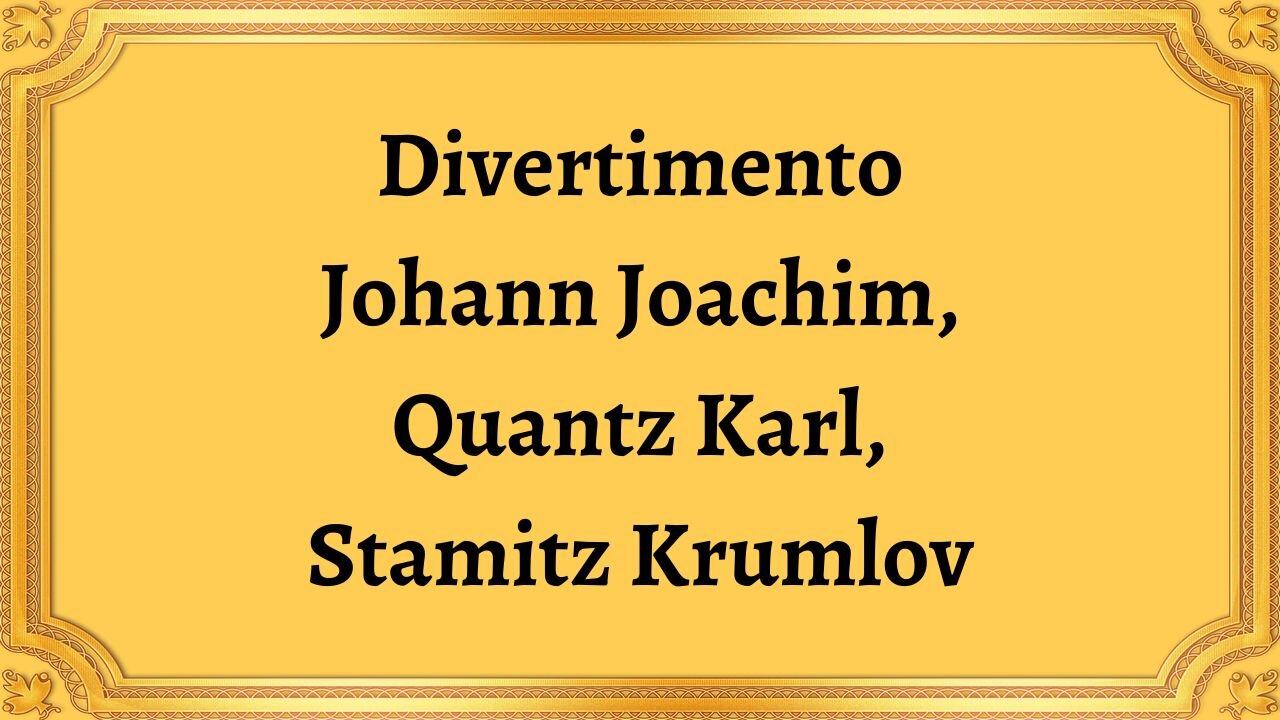Premium Only Content

Divertimento Johann Joachim, Quantz Karl, Stamitz Krumlov
#classicalmusic #musiccomposition #JohannJoachimQuantz #KarlStamitz #Krumlov #AgeofEnlightenment #melody #flute #strings #musicmovement #minuet #trio #adagio #allegro #musichistory
Divertimento Johann Joachim, Quantz Karl, Stamitz Krumlov is a classical piece of music that dates back to the mid-18th century. It is a representation of the era known as the Age of Enlightenment in Europe. The music is characterized by its simplicity, refined beauty, and a focus on melody as the main musical element.
The piece of music is a collaboration between three great composers, Johann Joachim Quantz, Karl Stamitz, and Krumlov. Johann Joachim Quantz was a German musician and composer who was born in 1697. He studied music in Italy and France and later became a flute player for Frederick the Great of Prussia. Karl Stamitz was a composer and violinist who was born in Mannheim, Germany in 1745. He was a prominent figure in the development of the Mannheim school of music. Krumlov, whose first name is not known, was a pupil of Stamitz and is known to have contributed to the composition of Divertimento.
Divertimento Johann Joachim, Quantz Karl, Stamitz Krumlov has a total of eight movements, each with its unique characteristics. The first movement is marked allegro, which means it should be played at a brisk, lively tempo. It is a fast-paced, energetic movement that sets the mood for the rest of the piece. The second movement is marked andante, which means it should be played at a moderate, walking tempo. It is a slow, graceful movement that showcases the beauty and elegance of the flute and strings.
The third and fourth movements are marked minuet and trio, respectively. These movements are both played at a moderate tempo and are characterized by their dance-like qualities. The minuet is a stately and elegant dance while the trio is a more lighthearted, playful dance.
The fifth movement is marked adagio and is a slow, lyrical movement that is characterized by its expressiveness and beauty. The sixth movement is marked allegro and is a fast-paced, virtuosic movement that showcases the technical skills of the performers.
The seventh movement is marked andante grazioso and is a slow, graceful movement that is characterized by its delicate and graceful melody. The final movement is marked allegro and is a fast-paced, playful movement filled with energy and excitement.
In conclusion, Divertimento Johann Joachim, Quantz Karl, Stamitz Krumlov is a beautiful piece of music that is a representation of the Age of Enlightenment in
You have the opportunity to support the channel https://destream.net/live/RadSiarAl/donate
-
 LIVE
LIVE
Steven Crowder
2 hours ago🔴 The True Cost of Fat Pride: How It's Destroying America
48,849 watching -
 LIVE
LIVE
Matt Kohrs
8 hours agoFed's FOMC Decision Day Chaos || The MK Show
1,674 watching -
 LIVE
LIVE
Caleb Hammer
38 minutes agoI've Never Met A Woman Like This | Financial Audit
307 watching -
 LIVE
LIVE
LFA TV
14 hours agoREMOVE MIKE JOHNSON! | LIVE FROM AMERICA 12.18.24 11am EST
2,380 watching -
 LIVE
LIVE
MYLUNCHBREAK CHANNEL PAGE
2 hours agoBuildings That Shouldn't Exist?
537 watching -
 42:09
42:09
BonginoReport
3 hours agoLock Her Up (Ep.107) - 12/18/2024
50.4K73 -
 LIVE
LIVE
Vigilant News Network
15 hours agoLiz Cheney’s Problems Just Got WORSE | The Daily Dose
1,308 watching -
 22:04
22:04
Scammer Payback
17 hours agoTorturing a Scammer Till They Give Up
4.16K9 -
 1:51:30
1:51:30
Game On!
14 hours ago $10.24 earnedConor McGregor vs Logan Paul: BIGGEST Boxing Match of the Century!
64.8K11 -
 1:04:06
1:04:06
2 MIKES LIVE
17 hours agoTHE MIKE SCHWARTZ SHOW with DR. MICHAEL J SCHWARTZ 12-18-2024
8.9K